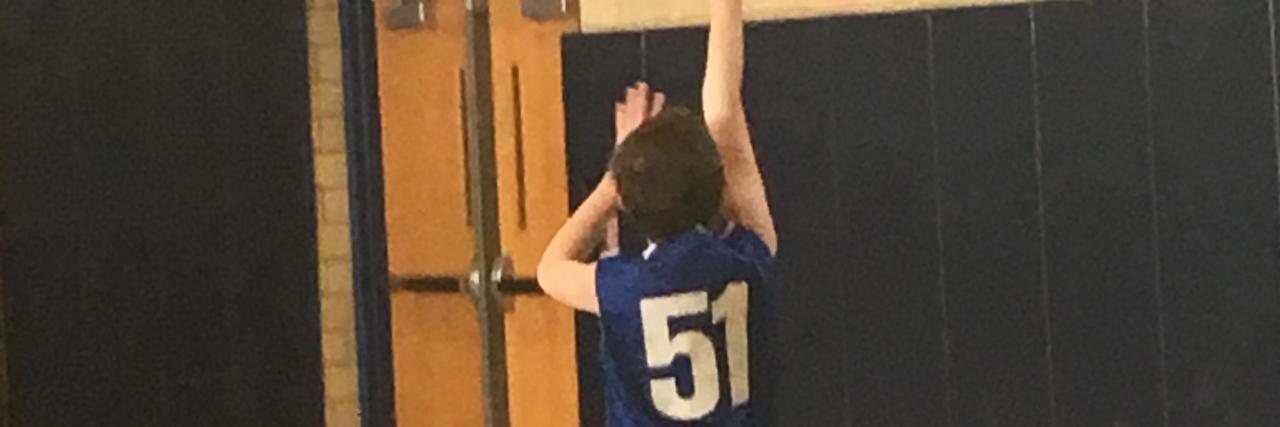My Son Has Found His Identity After His Ehlers-Danlos Diagnosis
When my son, Michael, turned 4, he asked for a basketball themed birthday party. We obliged; he’d recently become somewhat basketball obsessed, and even though most of the other kids were more interested in the bounce castle at the party, Michael was happy to celebrate his birthday by taking free throws.
• What is Ehlers-Danlos Syndrome?
• What Are Common Ehlers-Danlos Syndrome Symptoms?
The obsession continued. Later that year, he joined the YMCA kindergarten basketball league. Even though he wasn’t yet in kindergarten, and was shorter than the rest of the team, he kept up with the bigger kids and loved it. Michael played other sports — soccer, flag football, baseball — but basketball was his favorite and where he excelled. He couldn’t wait until fourth grade when he could try out for our town’s travel basketball program.
When that time came, Michael came home from the first tryout telling us how much fun he’d had. He was called back for a second tryout the following week. Despite being sidelined for the second tryout for what looked like a simple knee sprain, Michael was ecstatic to be placed on the “A” team.
Unfortunately, what had been diagnosed as a sprain turned out to be much worse than we thought. Shortly after the start of the season, Michael had two surgeries for a torn meniscus and ACL. He was out for the season. Fortunately, the coaches made Michael feel a part of the team to the extent that they could; he attended games and practices on crutches, cheered on the team and spent time recovering from his injury.
When basketball tryouts rolled around the following year, Michael hadn’t yet been cleared to participate fully in sports. Despite frustration with his slow recovery, he did what he could at the tryout and was placed on the “B” team. Just after the season started, Michael was cleared to play. He was thrilled to be back on the court, but after just two games, he was back on crutches with an injury to the other knee.
While this injury wasn’t as serious, it opened questions and led us to a geneticist, who answered those questions with a diagnosis of Ehlers-Danlos syndrome hypermobility type. Eventually, the injury healed and Michael was back to sports. By the next tryout, Michael had a few more minor injuries and had been out of sports for more than a year and a half in total. While Michael recovered and rehabbed, his peers grew stronger, developed skills and nurtured relationships with coaches. Michael still went back, did his best, and was again placed one team lower. He missed just a few weeks of that season due to injury, and was happy to be playing basketball.
Fast forward to this fall; Michael went to the travel basketball tryout and waited anxiously for weeks to hear about his placement. The email came in the middle of the school day. Michael wasn’t placed on any of the three travel teams. I assumed that not only would he be deeply disappointed, but he would hear the news from another seventh grader who
checked his phone during the school day. I was on edge for the afternoon until Michael returned home. He texted me from the bus: “I didn’t make travel.” He’d found out. I asked if he was OK and he said he was.
He got off the bus, and he really was OK. He seemed almost relieved. He said he was looking forward to playing in the less intense in-town league, and we later convinced him to try out for the YMCA travel league, so he’ll be playing on that team as well.
It’s been three years since Michael sustained an injury that changed the course of his childhood. He never got the chance to see what kind of athlete he would have become. As he gets older and many of his peers are a head or more taller, he sees that eventually the dream of playing basketball at a higher level probably would have been replaced by something else. For him, it just happened before he was able to understand the reasons why.
Thankfully, Michael is still able to play most of the sports he loves, just not in the way he thought he would be. He also started working with a yoga instructor (at his request), who has taught him to stretch effectively and manage pain through meditation.
Just yesterday, Michael told me he’s decided not to complain about the muscle tightness and pain he has as a result of his hypermobility. Why? Because complaining doesn’t help, and it certainly doesn’t take the pain away. Michael has been more resilient that we’ve ever imagined he could be. I’m sure his experiences with injuries, surgeries and EDS has changed who he is, but I think this version of him is pretty fantastic.
Editor’s note: This story has been published with permission from the author’s son.

